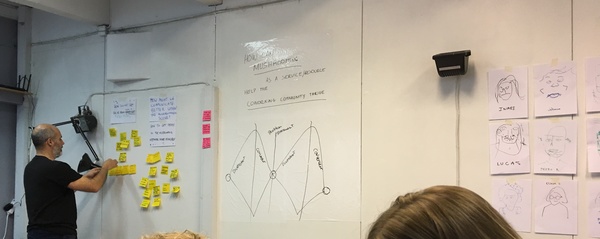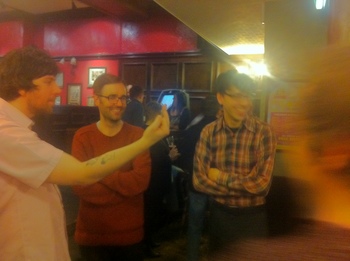Musings on Mutopia: a week of collaboration in rural Estonia
I spent the last 10 days in Estonia, mostly at the MoKS AVAMAA 2009 ArtSymposium. While the symposium offered traditional workshops (on printmaking and sound electronics), I participated in Mutopia 3, an exploration of collaborative creative practices that is quite difficult to describe.

Led by MoKS coordinator John Grzinich, the name is intended to combine the idea of Utopia with the process of mutation. And Mooste, Estonia does seem like some type of Utopia to my city-stained soul. A village of 500 people, about 40km from the also-charming Tartu, Mooste was far away from the distractions of my everyday life. The workshop was very focused on Mooste itself (though Mutopia 2 was held in Portugal) the ideas of place and space were perhaps the one common theme throughout.
I wrote an account of the activities we engaged in, but when I looked it over, I realised that my descriptions dont even begin to describe the workshop. One friend said it reminded him of the discussions in My Dinner With Andre, which I can understand, but the sum of the experience was much more than just a sequence of exercises and activities.
There were two aspects to Mutopia that I was most affected by - two surprises, I should say. The first was that the workshop, despite being comprised of and conducted by artists at an art symposium, wasnt really so much about art (or at least not to me). Yes, we engaged in artistic activities representational painting, performative interactions with the environment, sound construction, writing texts and the final product, I guess, were some short videos. But what really affected me was how much Mutopia was about the practices of creativity and observation in everyday life. The material that we worked with throughout the week came from our surroundings we found objects and places around the village, and extrapolated our experiences into language, action and image. We went to the forest for a morning and let the immense stillness of the Estonian trees provide a perfect scene for a sound exercise.

But around the somewhat structured creative exercises, we also engaged in games and physical exercises. These served initially as an icebreaker among a group of people, many of whom did not know each other but also as a way to define a relationship between performance/play and so-called artistic practice. Some games were silly, abstracted experiments in body language or mimicry; others were somewhat more structured, such as pretending to be monkeys, birds and eagles and using sound clues to guide one another. Or the challenge of picking blueberries in the forest while blindfolded - or even just picking kantarelli mushrooms, without being blindfolded.
The week was fairly light on theory and heavy on practice - and it was extremely collaborative, the second surprise. I expected it to be somewhat group-based, but I didnt think I would find it so natural to engage creatively with strangers. I didnt realise how much I have been working alone in the creative sphere (when I even have the time to work creatively, these days). I havent been engaged in any steady musical partnership since Lied Music went on hiatus, which was ages ago - apart from a few Bat Tarbet shows and some halfhearted mail collaborations. Being thrown into a week of working together with 10 people I didnt know before should have been intimidating, but somehow it worked - and I think this was felt by everyone. We didnt do the usual "day 1" introductions that you would expect - instead, we dove right into the workshop without prejudices or assumptions. Over the course of the week, we established relationships with each other through our activities and experiences together.

Writing was good - something else that I havent really done in a creative way for some time. My favorite of the Mutopia videos, seen below, was a film adaptation of a collaborative text I worked on. My individual text was combined with text from three other participants - taking a sentence from each of ours, in turn -- and the Oulipo N+7 method was used to replace all of the nouns in the collective prose. This was particularly fun because the dictionary we used was an old Soviet-era Estonian-English dictionary; their source for the English was dated so we ended up with words like birdlime and knuckleduster. This new text was integrated with the location of the trash dump - a pile of electronic refuse in the village that exerted some fascination on us - with the idea that the hodgepodge juxtapositions of N+7 nouns were reflected by the assortment of obsolete analog tvs and old kitchen equipment. In the film, the nouns are actually removed and replaced by equivalent objects.
Maybe I enjoyed this because it was absurd deconstruction, something I didnt expect from Mutopia. This video is like Zorns Lemma meeting the Nihilist Spasm Band, a surprising aesthetic to emerge from such a large group of participants.
Reading the texts was fun - the different readings for the Mud text (heard as the soundtrack to this video) gave me a glimpse of what it must be like to be stuck in the grooves of a Robert Ashley recording. A similar text mutation exercise was performed to create this text, and despite the seeming randomness, some incredibly poetic phrases emerged.
The videos are fun and tie together the locations, the group actions, and the sound pieces. We knew that our goal was some sort of dissemination of the work - presented before the Honey for the Ears concert on Saturday - and throughout the week we brainstormed together, working out different ideas and listening to each others suggestions. But despite this focus, the week really wasnt about the videos for me - no matter how dazzling they may have turned out, they would be inadequate representations of the practices and observations we underwent.
And now suddenly Im back in the everyday world of Helsinki, back to my warehouse space in a concrete jungle. It felt like home when I got off the ferry at Katajanokka, maybe for the first time of my many returns from abroad. Now Im faced with the challenge of applying what I got from Mutopia to my daily grind of digital preservation research, freelance web development, grocery shopping, and paying student loans. I think it would be wrong to assume I can perform every action as a creative one; but my sense of space feels heightened almost like a superpower. In Mutopia we found the sublime in seemingly commonplace objects and locations. Helsinki surely has an exponentially higher amount of spots, yet Ive never even begun to approach anything here like we approached, say, the Time Tunnel in Mooste.

Besides the fact that everyone I met was amazing, the whole environment was infused with a welcoming force. it quickly felt like a community -- maybe that is an easy way to feel? There was good food every night, free improvisation sessions in the barn, lots of cheap drinks and casual presentations of artistic work. Participants from all three workshops interacted with one another, and the presentation day at the end brought everyones work together. The current artists-in-residence at MoKS were really influential to the whole trip for me: Bruno Humberto, because he co-led Mutopia with John G and Taavi Tatsi; Kaspar Wimberley and Susanne Kudielka because they were always around for conversation and input. Plus, they invited me to participate in one of their actions, a moped procession through Mooste involving the teenage locals. I was quite struck by Susanne and Kaspars work because it really investigated and engaged with the community of Mooste, rather than just using the village as a spot to get away from wherever they usually are. The young Estonian children of Mooste seemed keen to engage with us, as MoKS is definitely a centre of interesting things from their point of view - here, the mask/instrument that Tara built in the Neanderthal Electronics workshop is demod by some kids.
But it's back to life now, where I will hopefully approach the ever-growing pile of unfinished projects at least slightly differently now. It's one thing to pick up new skills, but another to pick up a new way of thinking (which I feel this was).





